One of our Year End Wrap-up Blogs. Others include 2025 Year in Review, 2025 RunSignup Product Review, 2025 GiveSignup Product Recap, 2025 TicketSignup Product Recap, 2025 Infrastructure Report, 2026 Company Strategy, 2026 RunSignup Roadmap, 2026 AI Product Roadmap, 2026 GiveSignup Roadmap, 2026 TicketSignup Roadmap. These will come out incrementally between November and early 2025.
NOTE: With all the hype around AI, we are not forgetting the fundamental features events need to be successful. Please see our 2026 Product Roadmap for our non-AI related projects.
We declared 2025 as the Year of AI. We saw AI was going to become meaningfully productive for RunSignup and our customers over this past year. Indeed it has been a year of substantial progress:
- Over 500 Event Websites are now running our AI Chatbot to service thousands of participant questions per month.
- Vibe Coding leveraging our Open API and empowering customers, and creating libraries of add-on applications to the RunSignup platform like our Timer Utilities.
- RunSignup Customer Service Chatbot help answer event director questions and our Race Trends Analysis Agent is being used by customers to help races learn from thousands of others.
- Demonstration of the first Buy in Chat in the registration and ticket market.
- Internal release of our MCP Server.
- Extensive use of AI in our development team to improve productivity.
As we look forward to 2026, we plan to substantially increase the use of AI across our product. We see the large models getting better and better. We will be creating our own AI infrastructure to handle the large loads we expect to see from new ways our customers will be using their data, and growing their events. We will be baking AI right into many dashboard pages, and taking our website Chatbot from being an information source to being able to take actions like buying tickets and moving from the marathon to the half marathon. We also will create large data warehouses built specifically for AI to query.
We are splitting our efforts between our normal development plan and AI. We are doing this by creating an AI Team that will build our own AI Infrastructure in such a way that all developers will be able to easily add AI capabilities to various dashboards and features across the platform.
Remember, the main purpose of the Large Language Models we use on the backend like ChatGPT or Claude via API’s is to allow users to have natural language conversations, and receive natural language and AI-generated information based on the real RunSignup transactional system.

Let’s dig into the detailed plans.
AI Chatbot for Event Websites
The AI Chatbot is in use by over 500 event websites answering thousands of queries per month and is about to exit Beta. So far, it contains the following capabilities:
- Optimized training on the Website Content since it is tightly integrated with Website V2.
- FAQ Component.
- Chat history available to Event Directors, along with the ability train the AI model to improve responses.
- Integrated RunSignup Help Content for things like reset password.
- Real Time Results for natural language query across the history of an event (shows times for a person across years)
- Continuous upgrade of the underlying AI model that is best suited for this application.
In the near term, we will be automatically training the AI model on the Race Information with data directly from the platform for things like start time, race fee, giveaway sizes, etc. This will improve the real time accuracy of responses. Once this is deployed, we will take the Beta label off.
Later in the year, we will be introducing AI Actions like participant management actions of changing events, as well as “Buy in Chat”.
MCP for Leading LLM’s
We have a large number of MCP Tools already deployed. We have not opened these up to customers yet as we wait for more maturation in the market. The biggest benefit of these MCP tools being public will be the availability to let people securely access the information they want right in their preferred LLM like ChatGPT or Gemini. We anticipate this will happen sometime in Q1.
There will be two types of access. One for public information like race information and results. The other will require login to RunSignup from the Chat session for access to data that is typically obtained from the race director dashboard.
Our focus will be in a couple of areas:
- Race information for searching for events. This is called Generative Engine Optimization (GEO). This is the term used for what has been called SEO for optimizing searching in Google, but when people search within their Chat session. We want to make sure events hosted on RunSignup optimize their traffic automatically.
- Results information. First on a per race basis, but over time via our AI Results Warehouse MCP Tools (see below).
- “Buy in Chat” – Participant / Ticket Buyer / Donor Actions like buying in chat as well as participant management capabilities. We will be introducing these first in our own chat to ensure they are secure and scale appropriately. But the real opportunity is to enable these within anyone’s preferred LLM. So customers will find the event they want and then signup directly in ChatGPT, Gemini and others.
One of the other areas of maturation is the knowledge that a user’s preferred LLM will “know” about that person. Much like people can buy tickets with a simple couple of clicks with ApplePay, we expect that same functionality with ChatGPT and Gemini. What happens under the covers is that the LLM will share name, email and credit card securely with RunSignup just like ApplePay does today. This will make the buying experience greatly improved over the somewhat tedious chat session Duy has in the demo above.
RunSignup AI Infrastructure
Our largest project this year will be building our own infrastructure. We have an early prototype of this that Duy demonstrates in the above video. We need to finalize our infrastructure, harden it and ensure scalability. We will be building our own Chat, RAG, as well as Vector databases in addition to specialized data warehouses like the one we discuss below for Results.
This will all be part of our secure, independently audited PCI Level 1 infrastructure. We already have the core security infrastructure built with our work on OAuth2 DCR.
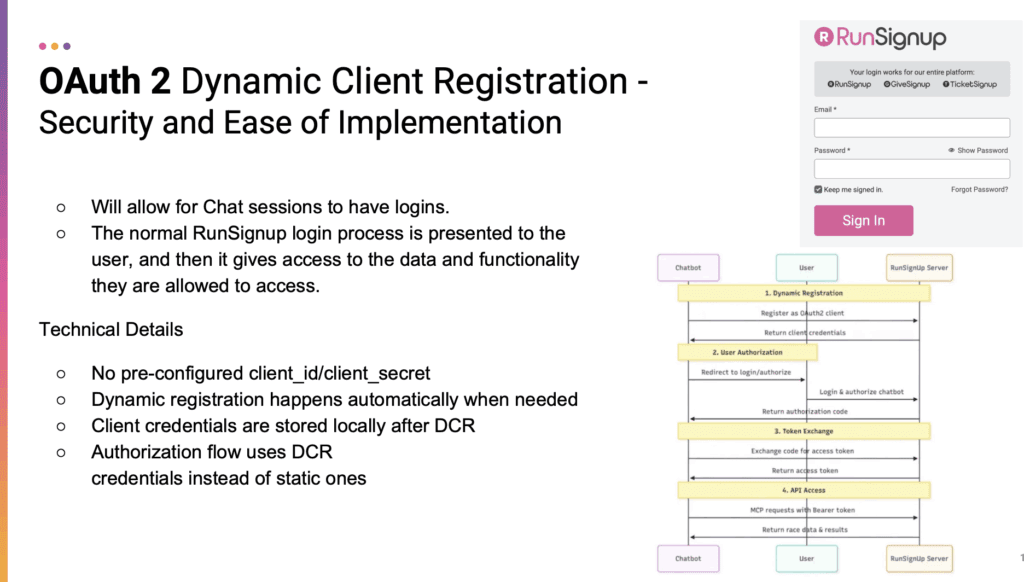
We will be building on the proven Amazon AWS Bedrock platform that is designed for building generative AI applications and agents. It provides us with simple ways to connect and switch between multiple LLM’s on the backend so we can switch from ChatGPT to Gemini to Claude easily and use different models for different applications. We already have an AI Agent application that we developed for detecting content spam running on AWS Bedrock and have been impressed with the productivity our team has achieved as well as the scalability.
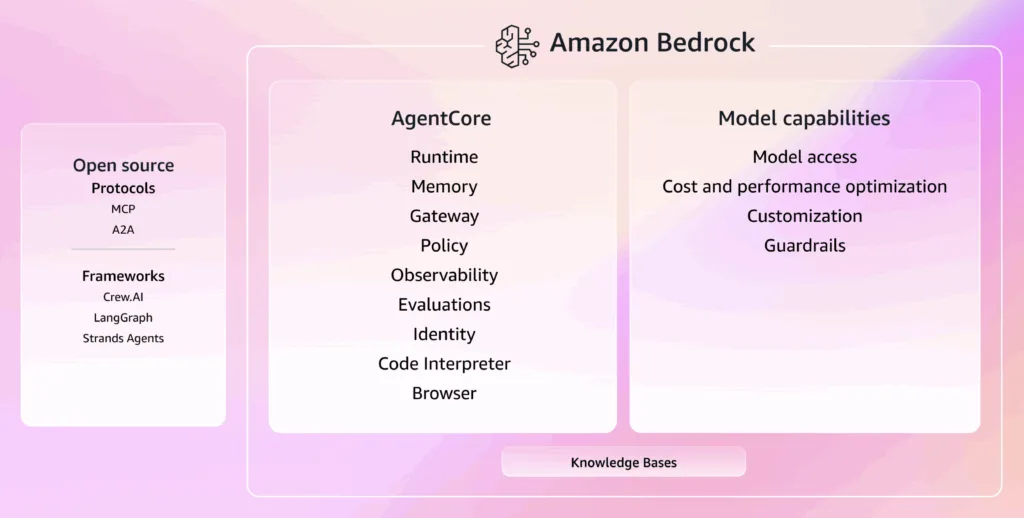
The goal is to have infrastructure that will allow the rest of our development team to create the various applications below. Our AI Development Team (Ryan, Jon, Phil and Duy) is heading to AWS Reinvent conference next week to learn and talk with others to make sure we are fully informed as we make this critical investment.
AI Actions for Event Websites
To enable real actions on the RunSignup system, we will need to deploy new AI infrastructure which will provide a next level of capability from our current Chatbot, which uses a third party for the chat interface. Some of the interactions we expect to develop will be dynamic based upon the rules that are set within each specific event. For example, one event might allow free transfers between events or downgrading from an expensive event to a less expensive event. But others might charge money and we will need to process a transaction.
We expect to release capabilities in 2026 for things like:
- Buy in Chat
- Change events
- Transfer to a friend
- Change Shirt size
- Update questions
- Deferral
- Refunds
It is also important to note that these capabilities will initially come within our own Chatbot, but will expand to be able to happen within ChatGPT and Gemini.
AI Actions for Director Dashboards
We will also use our own chat infrastructure to show AI to various dashboard pages to make changes. Here is a quick example of what it might look like for Referral Rewards:
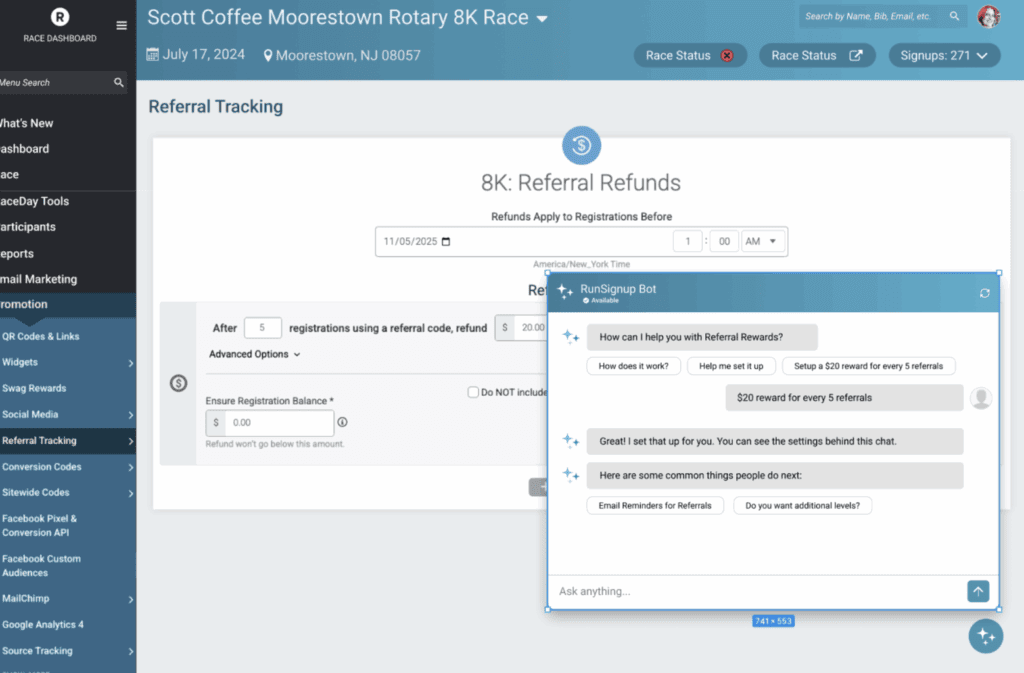
We expect this type of chat interface in to a number of dashboard pages across our products ini 2026. They will roll out incrementally starting around Q2.
AI Results Warehouse
RunSignup has tens of millions of results in our database and it grows by millions each year. We are going to create a Results Data Warehouse which will have a new set of MCP Tools to access it like these (note only smaller amounts of data are sent to the LLM, not millions of results, as that is not what it is designed for):
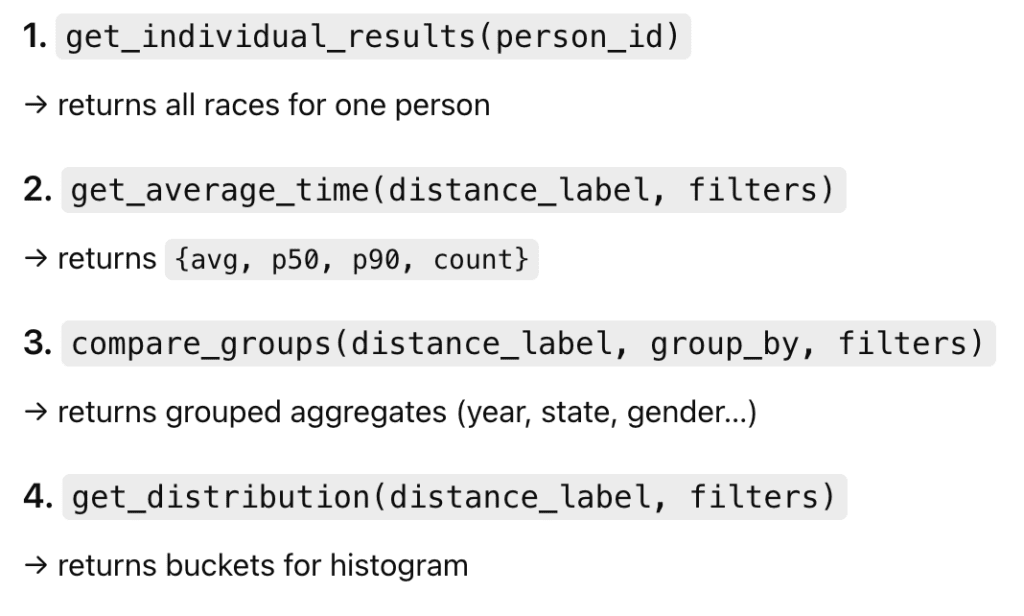
We will use those tools and create a public facing website where individuals will be able to research their past results and discover trends in their performances. Race Directors will also be able to study trends for their events, as well as the overall industry. Researchers at places like RunningUSA will be able to create studies on long term industry trends knowing this is all highly reliable data that is at critical mass.
As with all of our other MCP Tools, these will also become public and available from the LLM’s.
AI Analysis for Director Dashboards
Much like the results, we will also be creating efficient MCP Tools as well as specific warehouses and vector databases that are appropriate to enable efficient searching and summarizing to the LLM’s.
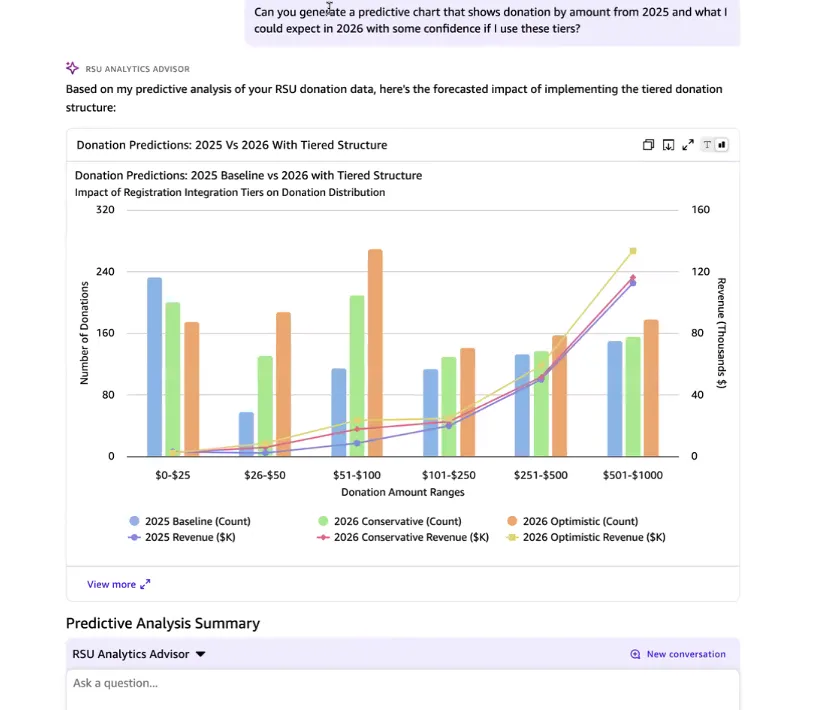
Much like the rest of these AI capabilities, it will take some time to build the infrastructure, and then each set of MCP Tools and capabilities. Over time, we would expect to see most reports in RunSignup to have Chat based interfaces.
In addition, once the MCP’s are built and the LLM’s are aware of them, event directors will be able to login with their RunSignup login from their favorite chat tool to get access to just their information.
AI Integration with Multiple Data Sources (Salesforce, Donor Management Systems, etc.)
Over the past several years we have partnered closely with an integration technology company, Sidekick. Like us, they are focused on events and the nonprofit sector. They built the public Zapier plugins to RunSignup that anyone can use. They have also consulted with dozens of mutual customers to help those customers integrate data from multiple systems like RunSignup and Salesforce.
Sidekick has developed a new set of technology that is based on creating large data warehouses that combine the data from multiple vendors and then provides both a Business Intelligence interface as well as an AI interface. They are offering this starting at $15K, which includes two data source and initial setup and hosting of all data and continuous data updates.
This is the modern solution to organizations with multiple data sources. Rather than the complexities and costs of a CRM, this provides easy access and analysis of complex, combined data from multiple sources. As an example, this chart shows large donors and what part of the revenue from each donor came via RunSignup activity and what came from Salesforce tracked donations:
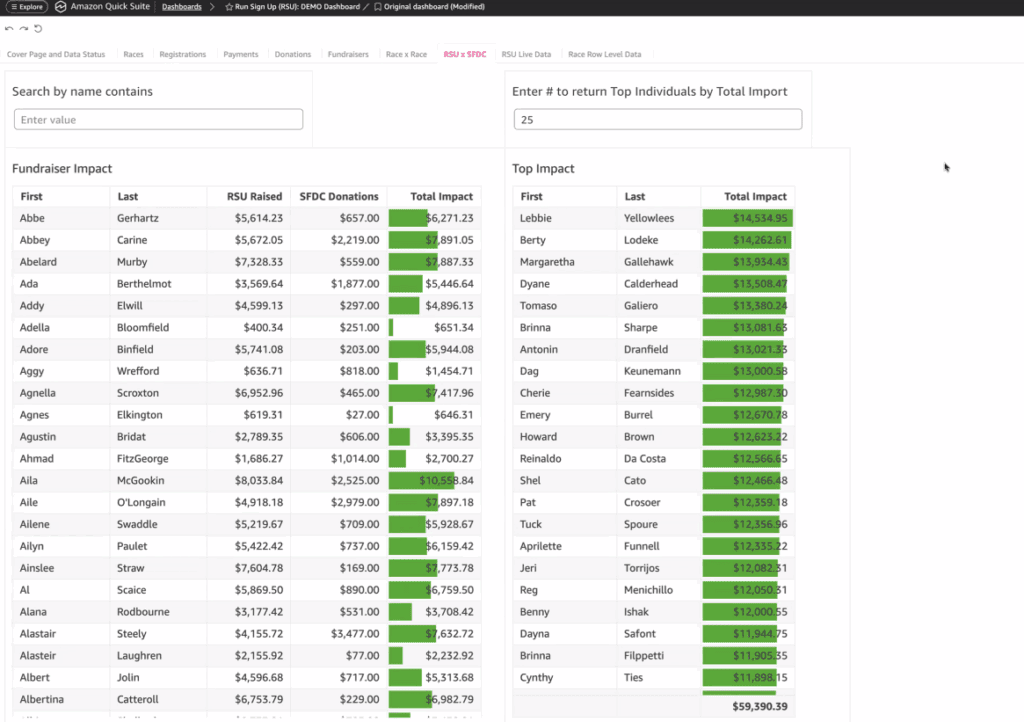
Generative UI
Finally, we expect that LLM’s will rapidly mature over the next couple of years. The simple chat interfaces that are widely used today will improve. The LLM’s will begin to create “Generative User Interfaces“. Google’s latest Gemini 3 release includes some interesting glimpses of the future of Generative UI. This means that customers accessing RunSignup from their favorite Chat will start to see more and more meaningful data from our MCP’s displayed in rich context. Imagine our an event with store item visuals displayed for purchase that would drastically improve upon a tedious chat session. Or demographic information displayed in a rich visual beyond a simple bar chart.
Our User Experience team will be following these developments closely and will be incorporating these ideas into our products as well.
Internal Development with AI
We have embraced doing development with AI this year. Most developers use Cursor. About half just use the tab completion features, and half are doing prompt based development. We expect prompt based development to become primary in 2026.
We saw a decrease in the number of releases early in 2025 as developers spent time learning Cursor, and we as an organization invested in training Cursor on our development style, putting in guardrails and experimenting. Andrew Burke demonstrates how he uses prompt based coding with Cursor in this video that he and Bruce did last month:
You can see how Cursor usage has increased as we have gone thru the year (August had a lot of vacation time):
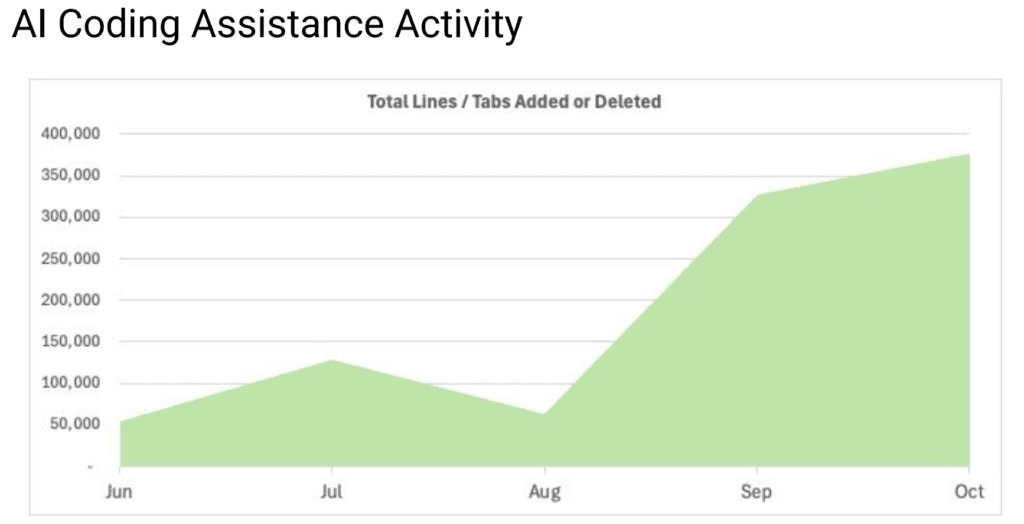
We expect to continue to become more and more productive. The AI models are becoming smarter. Our training of Cursor continues to make it smarter. And we are smarter about how we are using AI.
Summary
We see huge opportunities for us to provide pragmatic AI tools that will help our event customers grow. We will continue to press forward aggressively, but to be patient enough not to release bad software that puts the transactional integrity, reliability and security of our platform at risk.
Our entire team is embracing AI. We see AI giving us the ability to continue growing our company by making better products for our customers and for our customers to each grow as we release more features for them. A very virtuous circle.
